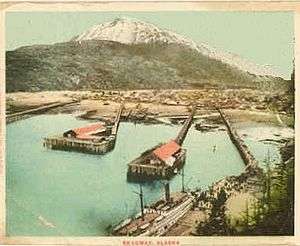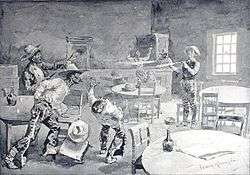Shootout on Juneau Wharf
|
The four docks in Skagway. Juneau Wharf is the second from the left. | |
| Date | July 8, 1898 |
|---|---|
| Location | Skagway, District of Alaska, USA |
| Participants | Jefferson Randolph Smith, Frank H. Reid, Jesse Murphy, Josias Martin Tanner, John Landers. |
| Outcome | 2 killed |
The Shootout on Juneau Wharf was a gunfight that occurred at about 9:15 pm on Friday, July 8, 1898, in Skagway, District of Alaska, in the United States. It was a duel between Jefferson Randolph 'Soapy' Smith and Frank H. Reid and Jesse Murphy, in which Smith and Reid were shot to death. They were fighting over the control of the town of Skagway, which at the time was an important port for the Klondike gold rush.
Background
The founding of Skagway, in December 1897, attracted western crime boss Jefferson Randolph "Soapy" Smith and his gang of confidence men to the port, as it was the main American town leading onto the White Pass Trail and into the Klondike gold fields discovered in 1896.[1] Soapy Smith set up his swindle operations and quickly became the region's underworld boss just as he had done in Denver and Creede, Colorado.[2]
Other men seeking control of Skagway formed a vigilante committee under the guise of law and order, but had little effect in the beginning.[3] Smith was popular and supported by many of the merchants in town as they benefited from the criminal operations of Smith and his men, who freely spent their ill-gotten gains in the local businesses. Smith also donated to numerous charitable causes in town. The vigilantes remained quiet and small in numbers.[4]
Victims of the gang's confidence swindles had little recourse; the deputy United States Marshal was receiving graft from Smith, enabling the gang to operate with little fear of arrest.[5] That, coupled with the already bogged-down legal system in the area, made resolution of crime difficult, at best.
The harsh and lawless environment invited crimes of violence probably not associated with Smith and his bunco men, but his opposition used the opportunity to place blame on Smith. Several murders, one after another, in March 1898, coupled with negative newspaper accounts about Skagway's lawless element, aroused fear and concern that the gold rush stampeders might abandon Skagway as an access point to the gold fields.[6]
A vigilance committee calling themselves the 101 demanded relief from the federal government.[7] When that proved too slow, they took matters into their own hands and posted handbills around Skagway ordering the bunco men to leave Skagway or face the consequences. Smith retaliated by forming his own "law and order committee", but he claimed his consisted of "317 citizens". He also had handbills printed up and posted around town warning the vigilantes from attempting to take the law into their own hands.[8] Tensions escalated and climaxed on July 8, 1898, with the robbery of a returning miner's gold.
Prelude
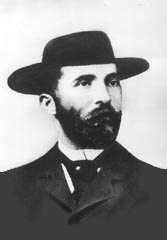
On July 8, 1898, John Douglas Stewart arrived in Skagway. returning from his claim in the Klondike with a canvas pouch containing $2,600 in gold and $87 in cash. Stewart placed his gold in a local store safe and rented a room to wait for passage on an outgoing steamer.
Around 10:00 am, Stewart was met by John L. "Reverend" Bowers and W. E. "Slim-Jim" Foster, two members of Soapy Smith's gang. They lured Stewart into the alleyway beside Jeff Smith's Parlor. Once there, they were joined by Van B. "Old Man" Triplett, who started up a game of three-card monte to swindle Stewart out of his gold. Stewart lost his $87 in cash, some of which Triplett then offered to return to continue the game. He was then asked to provide evidence that he could pay it back if he lost. Stewart reported what happened next:
I told Foster I should hold him for the money, and the old man, Van Triplett, said we acted as if we could not trust him, and gave some of the money back, and then said he would give us a chance to win it [all back], so Foster turned the right card and [Triplett] started to give him the money, but said, ‘Supposing you had bet that in earnest, did you have the money to put up?’ Foster said, ‘No,’ and turning to me said, ‘You have the money,’ and I said no, I did not have any money; that he took it all, but he said, ‘You have some dust,’ and wanted me to get it just to show the old man that we had the money in case the bet had been a real one. Bowers and I went to Kaufman’s store to get the money and Van Triplett and Foster remained behind. We came back with the dust and I unrolled it and showed them the sack, and the old man said he did not know if that was gold, and Bowers said, ‘Open it and show it to him, as he don’t know gold dust when he sees it,’ but I did not open it, and [was] just about to roll it up again, when Foster grabbed it and handing it to the old man, said, “Git!” and I started to grab the old man when they held me and said if I made a noise it would not be well for me. I pulled away from them and started after the old man, but could not see him and then went across the street and asked a party where there was an officer: that I had been robbed of $3,000 by some men over there.[9]
Stewart tried to file a complaint with Deputy US Marshal Sylvester S. Taylor but found no comfort. Taylor was under Smith's control and informed Stewart that if he kept quiet about the affair he (Taylor) would see what he could do. Stewart complained to anyone who would listen, including US Commissioner Sehlbrede stationed in the neighboring town of Dyea.
Learning of the unrest over the robbery, Smith took to the streets, mingling with the residents and merchants, and claiming that no one had been robbed. Smith argued that Stewart had lost his gold in a square game. Between 2 and 6 pm, “at least a dozen men went to Soapy Smith and tried to get him to disavow the robbery and give up the men.” Smith, however, maintained his position and “declined to do anything about the matter,” finally stating in exasperation “that if Stewart had not ‘hollered,’ he [Smith] would feel like going out and getting him a piece of the money” back.[10] In contrast with the Alaskan, Smith told several businessmen he would make amends.
During the early part of the excitement, Smith partially promised several men, including the writer, that … [if there were] no “roar” made in the papers, the gold would be returned by 4 o’clock that evening, and that his influence would be used to prevent his men from in any way interfering with returning Klondikers in the future.[11]
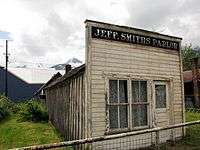
Smith had said the gold would be returned by four, but the hour passed with no word. When told by a Skaguay News reporter that unless the gold was returned, there would be trouble, Smith is said to have replied, "By God, trouble is what I am looking for."[12]
Arriving in Skaguay, Commissioner Sehlbrede sent for Smith to come to the marshal’s office. Smith arrived at 6 pm. In the presence of the marshal and a Daily Alaskan reporter, Sehlbrede demanded that the gold and the men responsible be turned in. Smith stuck to his defense that
the boys who had the money won it in a fair game and they should keep it. He also said he had a hundred men who would stand behind him and see that they were protected. The judge finally told him he [Smith] could not afford to stand up for a gang of thieves, but he [Smith] almost screamed—“Well, Judge, declare me in with the thieves. I’ll stay with them,” and with that he passionately beat the table with his fist and left the room.
Smith left the meeting, for Sehlbrede next got around to asking the men present in the room whether if he issued warrants, they would arrest Smith and his whole gang. The reply was unanimous and emphatic: Smith and every one of his men would be brought in. Sehlbrede added that “he wanted the men … alive if possible, but dead if necessary.”[13]
In the meantime, two separate vigilante groups, the Merchants Committee and the Citizens Committee, began to call for immediate action to rid the town of the bunco men. Several hundred people attended the latter organization's meeting at Sylvester Hall, too many for the facility to accommodate. It was rumored that members of the Soap Gang had infiltrated the hall to cause disruption. As a result, another meeting was called to be held at the end of the Skaguay Wharf Improvement Company, more commonly known as Juneau Wharf.
Shootout
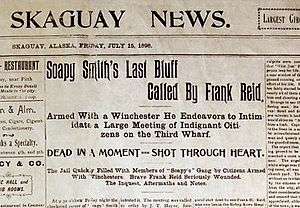
At the first meeting of the Citizens Committee, Thomas Whitten of the Golden North hotel had been elected chairman.[14] He appointed four men “to guard the approach to the dock in order that no objectionable characters might be admitted to disturb the deliberations of the meeting.” They were Frank H. Reid, Captain Josias Martin Tanner, Jesse Murphy, and John Landers.[15] They were unarmed except for Reid, the apparent leader of the four guards, who had a .38 revolver on his person.[16]
Reid, a 54-year-old resident of Oregon, had worked as a bartender in the Klondike Saloon, a gambling den under Smith's control. He became the city engineer and operated lot sales to miners.[17] Tanner was a 48-year-old captain of barges and steamers to and from Skagway.[18] After the shootout, he was appointed as a deputy US marshal.[19] Jesse Murphy was an Irish employee of the newly arrived White Pass and Yukon Railway.[20] Very little is known of John Landers.
On the evening of July 8, 1898, about 9 pm, Soapy Smith was inside Smith's Parlor drinking when William “Bill” Saportas, a reporter for the Daily Alaskan and a member of the Soap Gang came to Smith and gave him a note that read, “‘the crowd is angry, if you want to do anything do it quick.’ … [signed] ‘S’.”[21] Smith stuffed the note into his pocket, grabbed a Winchester Model 1892 .44-40 rifle and possibly his Colt Model 1889 New Army .41 caliber double-action revolver and decided to attend the vigilante meeting. With six or seven of his men following at a distance, he walked west on Holly to State Street and turned south toward the Juneau Wharf six blocks away.[22]
The wharf extended nearly 1/2 mile into the bay. It was between 15 and 20 feet wide and came straight in over the mud and gravel beach at a height of 6 to 10 feet.[23] At the wharf entrance, John Landers was talking with another man. About 60 feet down the wharf against the west railing, Josias Tanner and Jesse Murphy stood near one another. Frank Reid stood further on, alone. Their job was to identify Soap Gang members and prevent them from entering the meeting then in progress.[24]
Sometime between 9 and 9:30 pm, Smith approached the wharf entrance. He held his rifle over his right shoulder, muzzle pointing upwards and to the rear. At the entrance, he ordered the men who followed him to remain there while he proceeded alone up the center of the wharf. Approaching Landers and the other man, Smith ordered them off the wharf. They obeyed by jumping over the side to the beach about six feet below. Smith continued, passing Tanner and Murphy without addressing them, nor did they offer resistance. Smith continued towards Reid, who called out, “Halt, you can’t go down there.” Witnesses claimed Reid and Smith argued for a few seconds, swearing at each other.[25]
At this point Reid is generally believed to have still had his revolver tucked away and that Smith still had his Winchester shouldered, but about what happened in the few seconds before gunfire erupted, accounts differ greatly. Some accounts claim Reid drew his weapon first, while others claim Reid did not draw until Smith attempted to shoot him.[26]
The two men moved to face each other within a few feet. At some point, Smith suddenly swung his rifle off his shoulder and struck at Reid. Whether intending to shoot at that moment or to club Reid aside is uncertain. Reid raised his left arm to block the fast-approaching barrel. It struck and cut his arm, but he managed to grab the barrel and yank it away from the general direction of his head and press it downward.[27] The Daily Alaskan wrote that Reid grabbed the rifle barrel without being cut, but that during the scuffle, Smith pulled it free and hit Reid’s arm as he swung the rifle at Reid again.[28]

Reid grabbed the rifle barrel with his left hand and pressed it down, and with his right he drew his revolver (if not already drawn) and pointed it at Smith. At that moment, Smith is said to have shouted, “My God, don’t shoot!” Reid pulled the trigger, but the hammer fell on a faulty cartridge. Reid tried to shoot again as Smith jerked his rifle from Reid’s desperate grasp and quickly moved it in the direction of Reid.[29]
Many accounts state that both men fired in near perfect unison. Some stated it sounded as if one shot had been fired. “One witness said it looked as if the guns were spitting fire at the same time.”[30] Then, a number of shots followed, ranging between five and nine according to different testimonies. As reports tell of a total of five entry wounds in the two men, the minimum number of shots fired had to be five.[31] The exchange occurred rapidly. Reid received a bullet to one leg. Reid fired two more rounds, one grazing Smith’s left arm and the other striking his left thigh above the knee and exiting the other side. Chambering his Winchester, Smith sent a bullet into Reid’s lower abdomen and groin. Reid fell face down upon the planking, severely wounded.[32] It is not known if Smith remained standing or also had fallen.[33]
Seconds after the initial exchange of gunfire, Smith’s men began running toward their wounded leader, weapons drawn. Murphy rushed over to Smith and wrestled the Winchester from his hands and turned the rifle towards Smith. This is another moment believed to have been the time that Smith hollered out, “My God, don’t shoot,” but Murphy pulled the trigger killing him instantly with a bullet to the heart.[34]
Murphy, then faced with the charging gang members, raised the rifle toward them and took aim. Gang member W. H. Jackson pointed his revolver at Tanner, who testified that Jackson was “possibly twenty or thirty feet” away. Tanner was unarmed and could do nothing. Jackson probably noticed Murphy was aiming his now-dead boss' rifle in his direction. This, coupled with the fast-approaching men from the Citizen's Committee, who prematurely ended their meeting with the sound of gun fire, perhaps convinced Jackson not fire his pistol at Tanner. Someone yelled out towards the men who were with Smith, “They have killed Soapy, and if you don’t clear out quick they will kill you too.” Not wanting to engage in a gun battle in which they were vastly outnumbered, the gang fled.[35]
Smith's criminal empire was over and the vigilante leaders took over control and rounded up the Soap Gang.[36] The US Army stationed in Dyea threatened martial law.[37] It is believed by Soapy Smith's biographer, Jeff Smith, that the threats of martial law convinced the vigilantes, now in control of the town, to credit Frank Reid with killing Smith rather than risk military rule by admitting Murphy had shot and killed the wounded and unarmed Smith, which would most likely be construed as a murder. This led to many decades of a mistaken history.[38][39] Accounts of the second shooter came to light in biography by Jeff Smith citing numerous documents and accounts, including those of Murphy and Tanner, that clearly show Murphy had, in fact, shot and killed Smith.
Aftermath

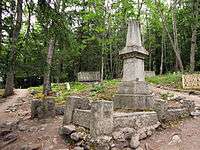
After the gang had fled, Tanner rushed over to Reid and asked for his pistol, which lay under him. Reid replied that he was badly hurt, but he managed to roll off his gun. Except for two empty shells and one unexploded cartridge, it was empty. Reid died from his wounds 12 days later. Despite the fact that Reid's own reputation was far from untarnished, his funeral was the largest in Skagway's history[40] and his gravestone was inscribed with the words "He gave his life for the honor of Skagway."[41] On July 14, 1898, six days after the robbery and gunfight, John Stewart's gold was found by vigilantes inside Soapy's trunk located in an outbuilding behind Jeff Smith's Parlor. All of the gold, minus $600, was there.[42]
Popular culture
Festivals
In Skagway, Alaska, July 8 is the annual (since 1974) Soapy Smith Wake, which is held at the Eagles Hall. This event used to take place at Soapy's graveside in the city cemetery, but is now held in the downtown area.
At The Magic Castle nightclub, in Hollywood, July 8 is the annual Soapy Smith Party, complete with costume contests, charity gambling, and magic shows to memorialize the day of the shootout.
See also
References and notes
- ↑ Smith, Jeff (2009). Alias Soapy Smith: The Life and Death of a Scoundrel, Klondike Research. pp. 435-36. ISBN 0-9819743-0-9
- ↑ Smith, Jeff (2009). Alias Soapy Smith: The Life and Death of a Scoundrel, Klondike Research. pp. 471. ISBN 0-9819743-0-9
- ↑ Smith, Jeff (2009). Alias Soapy Smith: The Life and Death of a Scoundrel, Klondike Research. pp. 438. ISBN 0-9819743-0-9
- ↑ Smith, Jeff (2009). Alias Soapy Smith: The Life and Death of a Scoundrel, Klondike Research. pp. 437. ISBN 0-9819743-0-9
- ↑ Smith, Jeff (2009). Alias Soapy Smith: The Life and Death of a Scoundrel, Klondike Research. pp. 528. ISBN 0-9819743-0-9
- ↑ Smith, Jeff (2009). Alias Soapy Smith: The Life and Death of a Scoundrel, Klondike Research. pp. 527. ISBN 0-9819743-0-9
- ↑ Smith, Jeff (2009). Alias Soapy Smith: The Life and Death of a Scoundrel, Klondike Research. pp. 470. ISBN 0-9819743-0-9
- ↑ Smith, Jeff (2009). Alias Soapy Smith: The Life and Death of a Scoundrel, Klondike Research. pp. 467-68. ISBN 0-9819743-0-9
- ↑ Tacoma Times 12/27/1898.
- ↑ Daily Alaskan Extra 07/11/1898
- ↑ Skaguay News 07/15/1898.
- ↑ Skaguay News 07/15/1898.
- ↑ Daily Alaskan Extra 07/11/1898
- ↑ Daily Alaskan 07/11/1898
- ↑ Skaguay News 07/15/1898
- ↑ Daily Alaskan 07/11/1898
- ↑ Smith, Jeff (2009) Alias Soapy Smith: The Life and Death of a Scoundrel, Klondike Research. pp. 439. ISBN 0-9819743-0-9
- ↑ Smith, Jeff (2009). Alias Soapy Smith: The Life and Death of a Scoundrel, Klondike Research. pp. 530. ISBN 0-9819743-0-9
- ↑ Smith, Jeff (2009). Alias Soapy Smith: The Life and Death of a Scoundrel, Klondike Research. pp. 562. ISBN 0-9819743-0-9
- ↑ Smith, Jeff (2009). Alias Soapy Smith: The Life and Death of a Scoundrel, Klondike Research. pp. 540. ISBN 0-9819743-0-9
- ↑ Smith, Jeff (2009). Alias Soapy Smith: The Life and Death of a Scoundrel, Klondike Research. pp. 532. ISBN 0-9819743-0-9
- ↑ Smith, Jeff (2009). Alias Soapy Smith: The Life and Death of a Scoundrel, Klondike Research. pp. 533. ISBN 0-9819743-0-9
- ↑ Smith, Jeff (2009). Alias Soapy Smith: The Life and Death of a Scoundrel, Klondike Research. pp. 533. ISBN 0-9819743-0-9
- ↑ Smith, Jeff (2009). Alias Soapy Smith: The Life and Death of a Scoundrel, Klondike Research. pp. 533. ISBN 0-9819743-0-9
- ↑ Smith, Jeff (2009). Alias Soapy Smith: The Life and Death of a Scoundrel, Klondike Research. pp. 533. ISBN 0-9819743-0-9
- ↑ Skaguay News 07/15/1898
- ↑ Skaguay News 07/15/1898
- ↑ Daily Alaskan 07/09/1898
- ↑ Skaguay News 07/15/1898
- ↑ The Alaska Sportsman The Real Soapy Smith 11/1947 p. 39
- ↑ Smith, Jeff (2009). Alias Soapy Smith: The Life and Death of a Scoundrel, Klondike Research. pp. 534. ISBN 0-9819743-0-9
- ↑ Skaguay News 07/11/1898
- ↑ Smith, Jeff (2009). Alias Soapy Smith: The Life and Death of a Scoundrel, Klondike Research. pp. 534. ISBN 0-9819743-0-9
- ↑ Smith, Jeff (2009). Alias Soapy Smith: The Life and Death of a Scoundrel, Klondike Research. pp. 535. ISBN 0-9819743-0-9
- ↑ Smith, Jeff (2009). Alias Soapy Smith: The Life and Death of a Scoundrel, Klondike Research. pp. 535. ISBN 0-9819743-0-9
- ↑ Smith, Jeff (2009). Alias Soapy Smith: The Life and Death of a Scoundrel, Klondike Research. pp. 562–574. ISBN 0-9819743-0-9
- ↑ Smith, Jeff (2009). Alias Soapy Smith: The Life and Death of a Scoundrel, Klondike Research. pp. 570. ISBN 0-9819743-0-9
- ↑ Mole, Rich. 2007. Gold Fever: Incredible Tales of the Klondike Gold Rush. P.133
- ↑ Pitcher, Don. 2007. Moon Alaska. P.158
- ↑ Mole, Rich. 2007. Gold Fever: Incredible Tales of the Klondike Gold Rush p.133
- ↑ Pitcher, Don. 2007. Moon Alaska p.158
- ↑ Smith. Jeff. 2009. Alias Soapy Smith: The Life and Death of a Scoundrel p.575
Further reading
- Collier, William R. and Edwin V. Westrate, The Reign of Soapy Smith: Monarch of Misrule, New York: Doubleday, Doran, 1935.
- Pullen, Harriet S., Soapy Smith Bandit of Skagway: How He Lived; How He Died, Stroller's Weekly Print, undated (early 1900s).
- Robertson, Frank G. and Beth Kay Harris, Soapy Smith: King of the Frontier Con Men, New York: Hastings House, 1961.
- Shea & Patten, The Soapy Smith Tragedy, The Daily Alaskan Print, 1907.
- Smith, Jeff, Alias Soapy Smith: The Life and Death of a Scoundrel, Juneau, Alaska: Klondike Research, 2009. ISBN 0-9819743-0-9
External links
- Fatal Duel – Historical Marker Database.
- Alias Soapy Smith – The Soapy Smith Preservation Trust website page with gunfight information.
- Art of a gunfight – Artwork of the shootout.
- Soapy Smith Forum – Discussion board and new information regarding Soapy Smith. Run by the descendants.
- Magic Castle – Photographs taken at the 2003–2009 Soapy Smith Wakes.
- Photo of group of vigilantes in Skagway about to go after Soapy Smith and his gang, U.Wash Digital Collections
